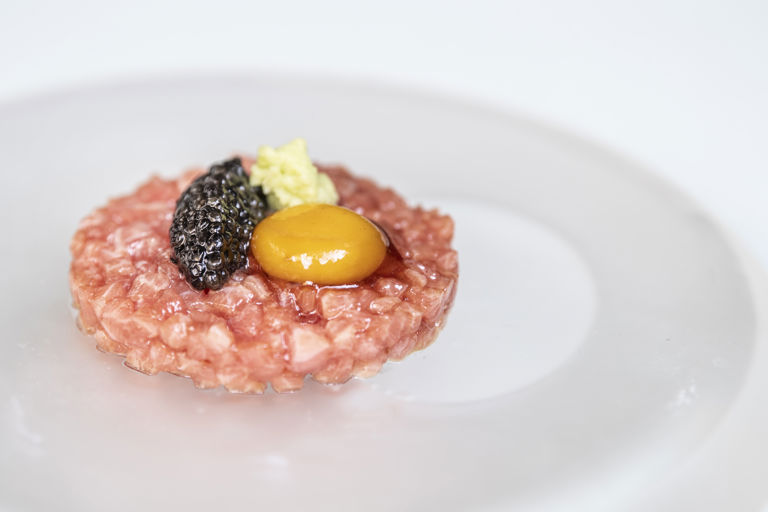Tuna tartare with soy-cured quail egg, caviar and wasabi

A masterclass in how a little patience and gentle cooking techniques such as curing and infusing can make some of the world’s most luxurious ingredients even tastier, this Japanese tuna tartare might be small – but it boasts a huge amount of pure, clean, umami-rich flavour. Well worth the expense of the seriously high-end ingredients. The tsukuri soy used to season the tuna and cure the quail egg yolk is also a fantastic umami bomb to have to hand in the fridge.
First published in 2021
Ingredients
Metric
Imperial
- 160g of fresh tuna, ideally from the fattiest part of the belly (known as toro)
- 4 quail eggs
- fresh wasabi
- 1 tbsp of caster sugar
Tsukuri soy
- 90g of light soy sauce
- 90g of mirin
- 1g of dried kombu
- 6g of bonito flakes
- 60g of tamari
Caviar
- 15g of Oscietra caviar
- 1 sheet of dried kombu, weighing approx. 10g
- 10g of sake, cooking grade
SAVE RECIPE
Method
1
The day before serving this dish you need to prepare the kombu for the caviar. Use a damp cloth to lightly pat the surface of the kombu, taking care not to remove the white powder-like substance on the surface of the seaweed (this contains a lot of umami flavour, so you don’t want to lose it). Combine the kombu and the sake in a vacuum bag and seal, then leave in the fridge overnight. If you don’t have a vacuum machine, place them both in a small plastic bag, expelling as much air as possible, then seal or fold. Keep in the fridge overnight
- 1 sheet of dried kombu, weighing approx. 10g
- 10g of sake, cooking grade
2
Prepare the tsukuri soy the day before too. Place the soy sauce, mirin and kombu in a pan, then cover and leave to infuse at room temperature for 2 hours
- 90g of light soy sauce
- 90g of mirin
- 1g of dried kombu
3
After 2 hours, place the pan over a medium heat and slowly bring to 60-65°C. Hold the mixture at that temperature for a few minutes, then increase to around 85°C. Add the bonito flakes, continue to simmer for a few minutes, then add the tamari and remove from the heat. Leave to cool and place in the fridge overnight
- 6g of bonito flakes
- 60g of tamari
4
The next day, strain the tsukuri soy through a muslin cloth (or a very fine sieve) and store in the fridge until needed
5
Remove the sake-infused kombu from the bag and gently spread the caviar over half of it. Fold the kombu in half to cover the caviar, then wrap the package in clingfilm, gently pressing it to expel any air. Place in the fridge and leave for 2 hours, so the flavours of the softened kombu infuse into the caviar
- 15g of Oscietra caviar
6
Wash the quail eggs under running water then very gently crack them open, separating the yolks from the whites (discard the whites). Place the yolks into a small bowl and pour over around 50g of the tsukuri soy. Set aside at room temperature for 2 hours
7
Once the caviar and egg yolks have been curing and infusing for 2 hours, finely dice the tuna into 2-3mm cubes. Season with 15g of the tsukuri soy
- 160g of fresh tuna, ideally from the fattiest part of the belly (known as toro)
8
Roughly trim the top of the wasabi rhizome and dip in caster sugar, then use a sharkskin grater to create a small amount of fresh wasabi paste
- fresh wasabi
- 1 tbsp of caster sugar
9
To serve, divide the tuna between 4 serving dishes, using a pastry ring to create a neat circle
10
Carefully unwrap the caviar and place a small spoonful on top of the tuna, with the cured egg yolk alongside. Finish with the wasabi
First published in 2021
Get in touch
Please sign in or register to send a comment to Great British Chefs.

